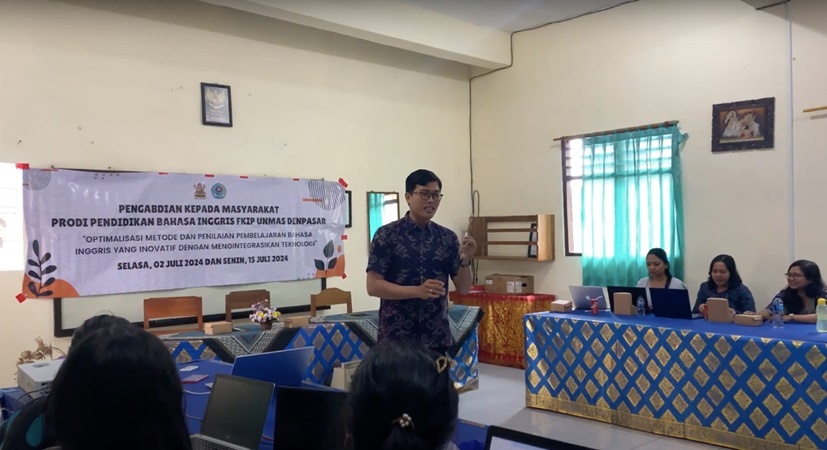Flipped Classroom sebagai Solusi Mutakhir untuk Pembelajaran Berbasis Digital Masa Kini
Flipped Classroom as the Cutting-edge Solution for Today’s Digital-based Learning
DOI:
https://doi.org/10.33084/pengabdianmu.v10i1.8424Keywords:
Flipped Classroom, Socialization, Training, AssistanceAbstract
Along with technological developments in the world of education, teachers are expected to always learn and adapt to technological developments so that the learning process in the classroom is more interesting. Apart from that, the teacher's ability to master and apply competencies in the field of technology, especially in the field of education, can help teachers develop learning materials and media so that they are always relevant to current developments. However, problems were found faced by teachers at the SMK Pariwisata Kertayasa Singakerta Ubud where their competence regarding the use of technology and teaching techniques was still not optimised. For this reason, the community service team provided the solutions that can be implemented by the community service team to solve the problems faced by partners. There is a solution that has been agreed upon, namely conducting socialization, training, and assistance in implementing the Flipped Classroom for the teachers as community service participants. The results of this community service activity show an increase in the teacher’s knowledge and understanding of implementing Flipped Classroom. Moreover, they gave a positive response to the activities provided by the community service team.
Downloads
References
Ayunda, A. T., & Atmojo, W. T. (2024). Pelatihan Flipped Classroom dalam implementasi education 4.0. Jurnal PKM: Pengabdian Kepada Masyarakat, 7(3), 323–332. https://doi.org/10.30998/jurnalpkm.v7i3.16429
Bergmann, J., & Sams, A. (2012). Flip your classroom: Reach every student in every class every day. Washington DC: International Society for Technology in Education.
Chen, Y., Wang, Y., Kinshuk, & Chen, N. S. (2014). Is FLIP enough? Or should we use the FLIPPED model instead? Computers and Education, 79, 16–27. https://doi.org/10.1016/j.compedu.2014.07.004
Cholik, M. (2023). Peningkatan hasil belajar siswa melalui penggunaan Quizizz sebagai alat pembelajaran interaktif di SMK. JIPI (Jurnal Ilmiah Penelitian dan Pembelajaran Informatika), 8(2), 428–435. https://doi.org/10.29100/jipi.v8i2.4156
Ismaniati, C., Muhtadi, A., Cobena, D. Y., & Soeparno, P. L. (2023). Effectiveness of flipped classroom on students’ learning outcome in vocational high school: A meta-analysis. International Journal of Instruction, 16(1), 589–604. https://doi.org/10.29333/iji.2023.16133a
Jr, A. C., & Pogoy, A. (2023). Teachers’ experiences in flipped classroom in South-East Asian countries: A meta-synthesis. Jurnal Pendidikan Progresif, 13(2), 218–229. https://doi.org/10.23960/jpp.v13.i2.20230
Mayasari, A., Supriani, Y., & Arifudin, O. (2021). Implementasi sistem informasi manajemen akademik berbasis teknologi informasi dalam meningkatkan mutu pelayanan pembelajaran di SMK. JIIP - Jurnal Ilmiah Ilmu Pendidikan, 4(5), 340–345. https://doi.org/10.54371/jiip.v4i5.277
Mubai, A., Ambiyar, A., Fadhilah, F., & Usmeldi, U. (2020). Meta analisis: Efektivitas model pembelajaran flipped classroom di pendidikan kejuruan. Jurnal Pembangunan Pendidikan: Fondasi dan Aplikasi, 8(1), 25–32. https://doi.org/10.21831/jppfa.v8i1.36542
Novianti, H., & Rukminingsih. (2021). Pelatihan pengembangan blended learning melalui model Flipped Classroom: Model pembelajaran alternatif di new normal era. J-ADIMAS (Jurnal Pengabdian Kepada Masyarakat), 9(2), 60–64. https://doi.org/10.29100/j-adimas.v9i2.2081
Oudbier, J., Spaai, G., Timmermans, K., & Boerboom, T. (2022). Enhancing the effectiveness of flipped classroom in health science education: a state-of-the-art review. BMC Medical Education, 22(1), 1–15. https://doi.org/10.1186/s12909-021-03052-5
Saunders, J. M. (2014). The flipped classroom: Its effect on student academic achievement, and critical thinking skills in High School Mathematics. Liberty University.
Sudrajat, Y., & Atmapratiwi, H. (2021). Pelatihan penggunaan blended learning melalui model Flipped Classroom. Jurnal Abdimas, 25(1), 17–21. https://doi.org/10.15294/abdimas.v25i1.23298
Susanti, R. (2013). Teknologi pendidikan dan peranannya dalam transformasi pendidikan. Jurnal Teknologi Pendidikan, 2(2), 15–23. https://doi.org/10.32832/tek.pend.v2i2.448
Tune, J. D., Sturek, M., & Basile, D. P. (2013). Flipped classroom model improves graduate student performance in cardiovascular, respiratory, and renal physiology. American Journal of Physiology - Advances in Physiology Education, 37(4), 316–320. https://doi.org/10.1152/advan.00091.2013
Unal, A., & Zafer, U. (2023). Design of flipped lessons in the classroom and opinions of teachers with different degrees of experience. Journal of Education and Practice, 14(9), 26–36. https://doi.org/10.7176/jep/14-9-05
Wibowo, D. E., Mahmudi, A., Pujiastuti, P., & Perdana, M. A. (2021). Persepsi penggunaan Flipped Classroom di sekolah dasar selama pandemi Covid 19. Jurnal Penelitian Ilmu Pendidikan, 14(2), 114–126. https://doi.org/10.21831/jpipfip.v14i2.37920
Widhiatama, D. A., & Dangin, D. (2021). Pelatihan penggunaan teknologi untuk pengajaran bahasa Inggris secara inovatif di kelas untuk guru-guru MGMP bahasa Inggris di Kabupaten Bantul. PengabdianMu: Jurnal Ilmiah Pengabdian Kepada Masyarakat, 6(4), 400–405. https://doi.org/10.33084/pengabdianmu.v6i4.1877
Yulian, R., Ruhama, U., & Alkadri, S. P. A. (2023). Pelatihan pengembangan Flipped Classroom berbasis Higher-Order Thinking Skills (HOTS) dan kurikulum merdeka bagi MGMP bahasa Inggris SMA Kabupaten Kubu Raya. Jurnal Abdi Insani, 10(3), 1647–1657. https://doi.org/10.29303/abdiinsani.v10i3.1085

Downloads
Published
How to Cite
Issue
Section
License
Copyright (c) 2025 Anak Agung Putri Maharani, I Gde Putu Agus Pramerta, Luh Ketut Sri Widhiasih, Wayan Maba, I Ketut Wardana

This work is licensed under a Creative Commons Attribution-ShareAlike 4.0 International License.
Authors who publish with this journal agree to the following terms:
- Any article on the copyright is retained by the author(s).
- Author grant the journal, right of first publication with the work simultaneously licensed under a Creative Commons Attribution License that allows others to share work with acknowledgment of the work authors and initial publications in this journal.
- Authors are able to enter into a separate, additional contractual arrangements for non-exclusive distribution of published articles of work (eg, post-institutional repository) or publish it in a book, with acknowledgment of its initial publication in this journal.
- Authors are permitted and encouraged to post their work online (e.g., in institutional repositories or on their websites) prior to and during the submission process, as can lead to productive exchanges, as well as earlier and greater citation of published work.
- The article and any associated published material is distributed under the Creative Commons Attribution-ShareAlike 4.0 International License










